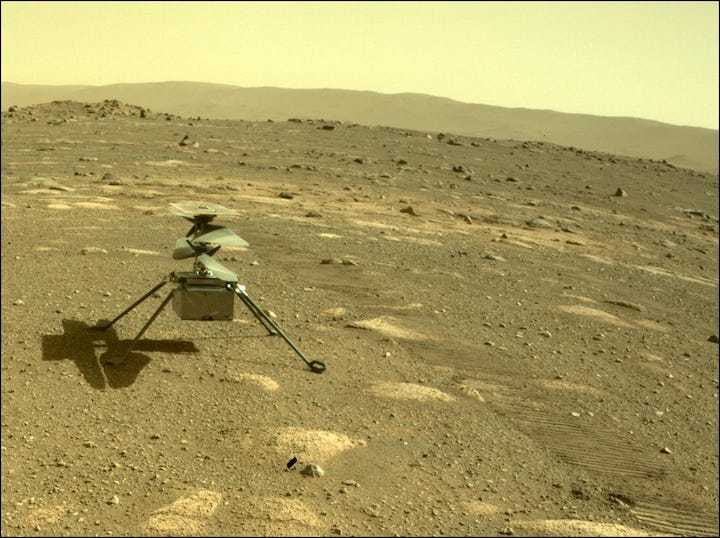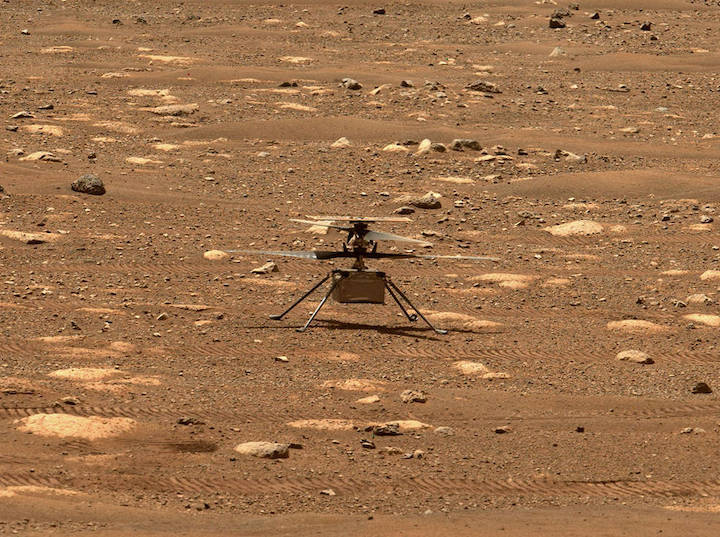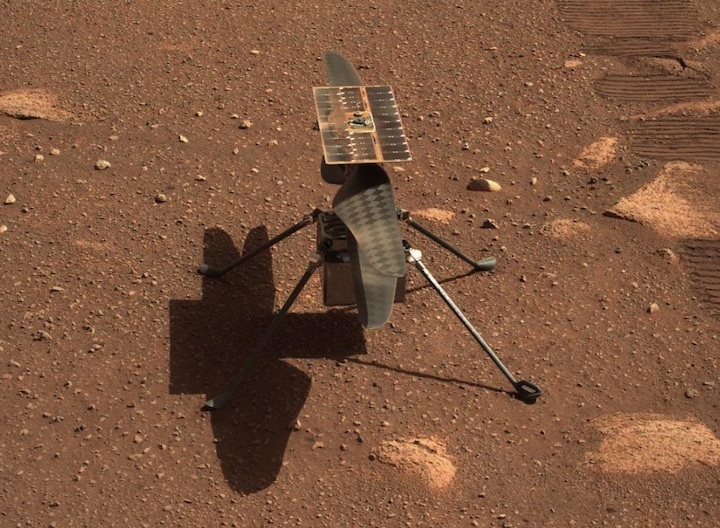Based on data from the Ingenuity Mars helicopter that arrived late Friday night, NASA has chosen to reschedule the Ingenuity Mars Helicopter’s first experimental flight to no earlier than April 14.
During a high-speed spin test of the rotors on Friday, the command sequence controlling the test ended early due to a “watchdog” timer expiration. This occurred as it was trying to transition the flight computer from ‘Pre-Flight’ to ‘Flight’ mode. The helicopter is safe and healthy and communicated its full telemetry set to Earth.
The watchdog timer oversees the command sequence and alerts the system to any potential issues. It helps the system stay safe by not proceeding if an issue is observed and worked as planned.
The helicopter team is reviewing telemetry to diagnose and understand the issue. Following that, they will reschedule the full-speed test.
Quelle: NASA
----
Update: 12.04.2021
.
Nasa preparing to attempt first controlled flight on another world
The Ingenuity helicopter, which arrived on the red planet in February, is expected to take to the skies on Wednesday
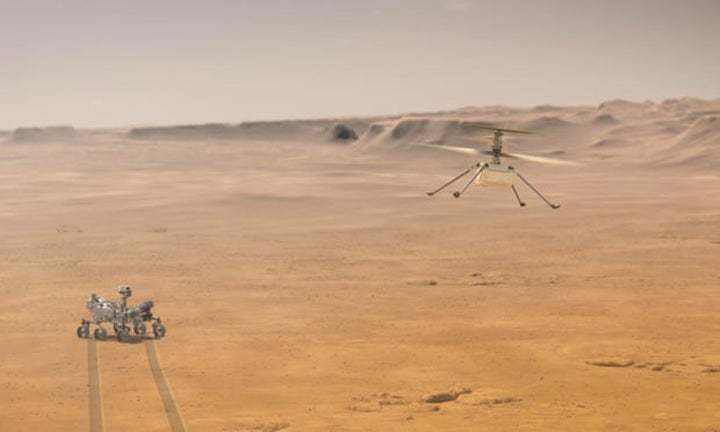
Nasa is gearing up to attempt the first controlled flight on another planet next week, with the tiny Ingenuity helicopter on Mars.
The helicopter is expected to take to the skies next week, with Wednesday being the earliest time scheduled.
Ingenuity arrived at the Jezero Crater on the red planet on 18 February after an eight-month journey spanning nearly 300 million miles inside the Perseverance rover.
Take-off had been scheduled for Monday, but Nasa said this was delayed after a technical issue during a rotor test, which means another test is now needed prior to the launch.
The helicopter is 50cm tall and weighs 1.8kg on Earth, but, due to the red planet’s lower gravity, a mere 680g on Mars. It is armed with two rotors that spin in opposite directions to lift the drone off the ground.
“During a high-speed spin test of the rotors on Friday, the command sequence controlling the test ended early due to a ‘watchdog’ timer expiration,” Nasa said.
“This occurred as it was trying to transition the flight computer from ‘Pre-Flight’ to ‘Flight’ mode. The helicopter is safe and healthy and communicated its full telemetry set to Earth.
“The watchdog timer oversees the command sequence and alerts the system to any potential issues. It helps the system stay safe by not proceeding if an issue is observed and worked as planned.”
After the spacecraft landed, it dropped the drone on to the ground so the aircraft could prepare for its maiden flight. It is part of a technology demonstration: a project that aims to test a new capability for the first time. As such, it does not have any scientific instruments onboard.
According to Nasa, one of Ingenuity’s key objectives is to survive the “bone-chilling temperatures” of the planet with “nights as cold as minus 90C”. It also faces the challenge of flying in Mars’s atmosphere, which is about 100 times thinner than Earth’s.
For its first flight, the helicopter will take off from the ground and hover in the air at about 3 metres for 20 to 30 seconds before descending and touching back down on the Martian surface.
If successful, Nasa says it will be a “major milestone” – the very first powered flight in another world.
The aircraft will then attempt additional experimental flights, which will involve travelling further distances and increasing altitudes.
It is designed to be mostly autonomous so Nasa will not be able to control the helicopter remotely due to the distance between Earth and Mars. It takes more than 11 minutes to get a radio signal back to Earth.
Last month the Perseverance rover sent back the first ever sounds of driving on the red planet – a grinding, clanking and banging noise.
Quelle: The Guardian
----
Update: 13.04.2021
.
Work Progresses Toward Ingenuity’s First Flight on Mars
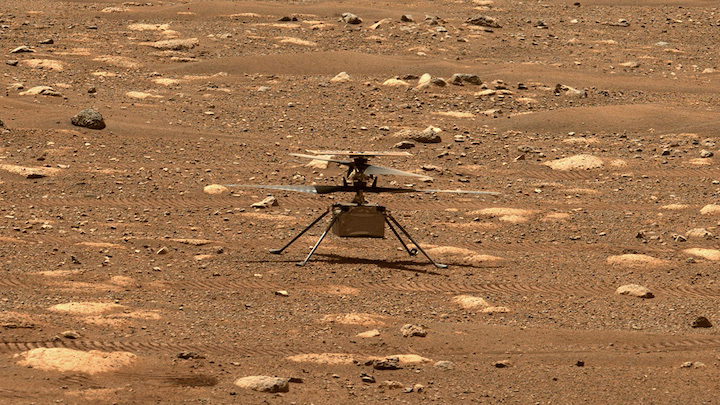
The Ingenuity team has identified a software solution for the command sequence issue identified on Sol 49 (April 9) during a planned high-speed spin-up test of the helicopter’s rotors. Over the weekend, the team considered and tested multiple potential solutions to this issue, concluding that minor modification and reinstallation of Ingenuity’s flight control software is the most robust path forward. This software update will modify the process by which the two flight controllers boot up, allowing the hardware and software to safely transition to the flight state. Modifications to the flight software are being independently reviewed and validated today and tomorrow in testbeds at JPL.
While the development of the new software change is straightforward, the process of validating it and completing its uplink to Ingenuity will take some time. A detailed timeline for rescheduling the high-speed spin-up test and first flight is still in process. The process of updating Ingenuity’s flight control software will follow established processes for validation with careful and deliberate steps to move the new software through the rover to the base station and then to the helicopter. Intermediate milestones include:
• Diagnose the issue and develop potential solutions
• Develop/validate and upload software
• Load flight software onto flight controllers
• Boot Ingenuity on new flight software
Once we have passed these milestones, we will prepare Ingenuity for its first flight, which will take several sols, or Mars days. Our best estimate of a targeted flight date is fluid right now, but we are working toward achieving these milestones and will set a flight date next week. We are confident in the team’s ability to work through this challenge and prepare for Ingenuity’s historic first controlled powered flight on another planet.
Ingenuity continues to be healthy on the surface on Mars. Critical functions such as power, communications, and thermal control are stable. It is not unexpected for a technology demonstration like this to encounter challenges that need to be worked in real time. The high-risk, high-reward approach we have taken to the first powered, controlled flight on another planet allows us to push the performance envelope in ways we could not with a mission designed to last for years such as Perseverance. In the meantime, while the Ingenuity team does its work, Perseverance will continue to do science with its suite of instruments and is gearing up for a test of the MOXIE technology demonstration.
Quelle: NASA
+++
Mars helicopter needs a software update before attempting first flight
NASA said Monday the Ingenuity helicopter needs a software update to resolve a problem that cut short the drone’s rotor startup sequence on Mars last week, postponing the craft’s first flight in the Red Planet’s atmosphere until later this month.
The helicopter — set to try to become the first craft to perform powered flight in the atmosphere of another planet — aborted an attempted spin-up of the its counter-rotating blades Friday after its autonomous control software detected a problem.
The lightweight helicopter was programmed to power up its rotors to flight speed near 2,500 rpm for a final pre-flight checkout Friday, leading to an attempt at a first flight Sunday, April 11. But the premature end to the high-speed spin test prompted ground teams to delay Ingenuity’s first test flight to no earlier than Wednesday, April 14.
In an update released late Monday by NASA’s Jet Propulsion Laboratory, mission managers said engineers identified a software fix for the “command sequence issue” that ended the high-speed spin-up test Friday.
Officials at JPL, which manages the Ingenuity helicopter project, did not announce a new target date for the rotorcraft’s first test flight. Ground teams hope to determine a new target date next week for the helicopter’s first flight.
Ingenuity is a small robot drone with a mass of just 1.8 kilograms (4 pounds on Earth or 1.5 pounds in Martian gravity) that rode to Mars on the belly of NASA’s Perseverance rover. Perseverance landed on the Red Planet on Feb. 18 with a primary objective of locating, collecting, and sealing rock specimens for return to Earth by a future mission.
NASA tacked on the $80 million helicopter as a technology demonstration, and agency officials gave Ingenuity 31 days to complete its flight experiments from the time Perseverance deployed the rotorcraft from its belly April 3.
Since then, the six-wheeled rover has driven to an observation location roughly 200 feet ( 60 meters) from Ingenuity’s flight zone. Perseverance will try to take pictures and video of Ingenuity’s first flight, which engineers expect will last around 40 seconds as the drone takes off to an altitude of about 10 feet (3 meters), momentarily hovers there, then rotates to point in a different direction before landing back on its four carbon-fiber legs.
If the first flight is as successful as NASA hopes, Ingenuity could fly four more times in subsequent weeks, trying more daring flight profiles before wrapping up the test flight campaign in early May.
Since separating from the rover April 3, the helicopter has demonstrated it can survive on its own power generated through a small solar panel. Ground teams also successfully unlocked the rotor blades, spanning nearly 4 feet (1.2 meters) tip-to-tip, for a low-speed spin test of 50 rpm last week.
The command sequence for the high-speed spin test Friday ended early as the helicopter was trying to transition the flight computer from “pre-flight” to “flight” mode, according to NASA. A watchdog timer system designed to oversee the command sequence expired before the completion of the spin test, ending the helicopter’s pre-loaded command sequence.
NASA said Monday that engineers over the weekend decided they will reinstall Ingenuity’s flight control software with a “minor modification” to the process that boots up the helicopter’s two flight computers. The change will allow the helicopter’s hardware and software safely transition to the flight mode, officials said.

Ground crews at JPL are reviewing and validating the software update in testbeds over the next two days.
Once that is complete, engineers will take “careful and deliberate steps” to upload the new software to the Perseverance rover. Perseverance has a radio base station that routes all communications between Earth and the Ingenuity helicopter.
Finally, the updated software will arrive on Ingenuity for installation into the flight computers. Then the helicopter will be ready to boot up using the new code.
“Once we have passed these milestones, we will prepare Ingenuity for its first flight, which will take several sols, or Mars days,” NASA said Monday. “Our best estimate of a targeted flight date is fluid right now, but we are working toward achieving these milestones and will set a flight date next week.
“We are confident in the team’s ability to work through this challenge and prepare for Ingenuity’s historic first controlled powered flight on another planet,” NASA said.
Ingenuity is otherwise healthy with stable power, communications, and thermal control to guard against the frigid nighttime temperatures on Mars.
“It is not unexpected for a technology demonstration like this to encounter challenges that need to be worked in real time,” NASA said. “The high-risk, high-reward approach we have taken to the first powered, controlled flight on another planet allows us to push the performance envelope in ways we could not with a mission designed to last for years, such as Perseverance.”
Quelle: SN
----
Update: 14.04.2021
.
NASA's Mars helicopter not quite ready for first flight on another planet
Making spaceflight history will have to wait another week. The flight of NASA’s Mars helicopter Ingenuity has been delayed due to software issues.
During a planned high-speed spin-up test of the helicopter’s rotors, engineers discovered a “command sequence issue.” The team at Jet Propulsion Laboratory also quickly discovered a solution. Basically, Ingenuity needs a re-boot.
NASA plans to set a new flight date sometime next week.
First the team will upload and reinstall Ingenuity’s flight control software. This software update will modify the process by which the two flight controllers boot up, allowing the hardware and software to safely transition to the flight state. Engineers will then load the software onto the flight controllers and then boot Ingenuity on the new flight software.
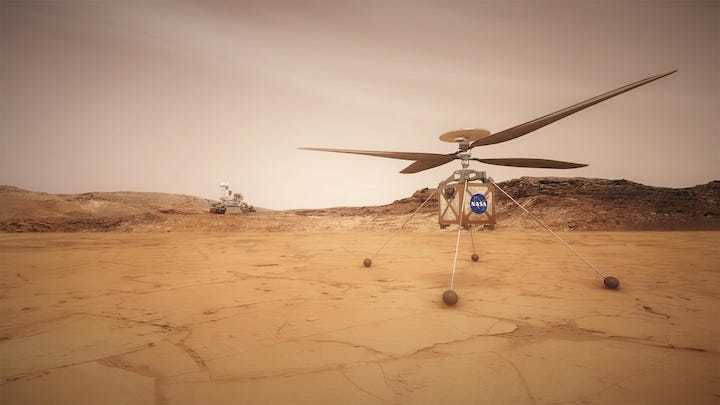
Meanwhile, Ingenuity continues to be healthy on the surface of Mars. Critical functions such as power, communications, and thermal control are all stable.
Ingenuity arrived on the red planet Feb. 18 attached to the underside of the Martian rover Perseverance. Ingenuity's flight is considered a technology demonstration and is not critical to the science Perseverance is doing namely for searching for ancient microbial life on Mars.
"The high-risk, high-reward approach we have taken to the first powered, controlled flight on another planet allows us to push the performance envelope in ways we could not with a mission designed to last for years such as Perseverance," NASA said in a blog post.
Once Ingenuity is ready, the first test flight will consist of a simple take off, hover around 15 feet off the ground and land back down.
The team plans to demonstrate the helicopter's flying abilities with several flights over a period of up to 31 days. Perseverance will provide support during flight operations, taking images, collecting environmental data, and hosting the base station that enables the helicopter to communicate with mission controllers on Earth.
Quelle: Florida Today
----
Update: 18.04.2021
.
NASA is targeting no earlier than Monday, April 19, for the first flight of its Ingenuity Mars Helicopter at approximately 3:30 a.m. EDT (12:30 a.m. PDT).
Data from the first flight will return to Earth a few hours following the autonomous flight. A livestream will begin at 6:15 a.m. EDT (3:15 a.m. PDT), as the helicopter team prepares to receive the data downlink in the Space Flight Operations Facility at NASA’s Jet Propulsion Laboratory (JPL). Watch on NASA Television, the agency app, website, and social media platforms, including YouTube and Facebook.
If the flight takes place April 19, a postflight briefing will be held at 2 p.m. EDT (11 a.m. PDT).
The participants are:
- Thomas Zurbuchen, associate administrator of NASA’s Science Mission Directorate
- Michael Watkins, JPL director
- MiMi Aung, Ingenuity Mars Helicopter project manager at JPL
- Bob Balaram, Ingenuity Mars Helicopter chief engineer at JPL
- Håvard Grip, Ingenuity Mars Helicopter chief pilot at JPL
- Justin Maki, Perseverance Mars rover imaging scientist and deputy principal investigator of Mastcam-Z instrument at JPL
Members of the media who wish to participate in the briefing by telephone must provide their name and affiliation to Rexana Vizza at rexana.v.vizza@jpl.nasa.gov by 12 p.m. EDT (9 a.m. PDT) April 19. Due to operational schedules, limited interview opportunities will be available to media before the Monday flight. To request an interview, go to:
https://bit.ly/mars-landing-media
The public and media also may ask questions on social media during the livestream and briefing using #MarsHelicopter.
Find the latest schedule updates at:
https://mars.nasa.gov/technology/helicopter/#Watch-Online
The original flight date of April 11 shifted as engineers worked on preflight checks and a solution to a command sequence issue. The Perseverance rover will provide support during flight operations, taking images, collecting environmental data, and hosting the base station that enables the helicopter to communicate with mission controllers on Earth.
This technology demonstration is supported by NASA’s Science, Aeronautics Research, and Space Technology mission directorates. JPL, managed for NASA by Caltech in Pasadena, California, built and manages operations for Ingenuity and the Mars 2020 Perseverance rover.
Quelle: NASA

